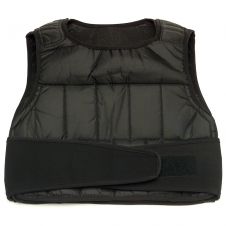Specific Sensory Interventions and Autism
Introduction
 There are a number of interventions which use one or more specific senses as an intervention technique or which are designed to help someone improve one or more specific senses.
There are a number of interventions which use one or more specific senses as an intervention technique or which are designed to help someone improve one or more specific senses.
We have divided this section into:
interoception, proprioception and vestibular-based interventions, such as weighted items
sight-based interventions, such as coloured filters
sound-based interventions, such as auditory integration training
smell and taste-based interventions, such as aromatherapy
touch-based interventions, such as brushing
Please note: there are a number of interventions, such as sensory integrative therapy, which use a wide range of different sensory techniques and / or which are designed to improve a range of senses. We have provided information about these interventions in the section on Combined, Multicomponent Sensory Interventions.
Evidence
The evidence for interventions based around specific senses is mixed. Auditory integration training does not provide any benefits for autistic people according to very limited research evidence of sufficiently high quality. Determining the benefits of any other sensory interventions for autistic people is not currently possible. We must wait for further research of sufficiently high quality to be completed.
Risks and Safety
Some risks are involved in some forms of sensory intervention. For example, risks come from using specialist equipment (such as some of the machines used in auditory integration training) or specialist materials (such as weighted vests and blankets).
Specific Senses
Interoception, Proprioception and Vestibular-Based Interventions
Interoception is the sense that helps you understand and feel what's going on inside your body
Proprioception is the sense of that allows you to perceive the position and movement of your body.
Vestibular sense is the sense that allows you to maintain balance and body posture.
Interoception, proprioception and vestibular-based interventions are any interventions which are designed to help people improve their interoceptive, proprioceptive or vestibular abilities.
Interoception, proprioception and vestibular-based interventions include the use of weighted items (such as blankets and vests) and some forms of equine assisted activities and therapies (such as hippotherapy).
More information
Please see
- our evaluation of Equine-Assisted Activities and Therapies
- publications on Equine-Assisted Activities and Therapies
- our evaluation of Weighted Items
- publications on Weighted Items
Sight-Based Interventions
Sight-based interventions are any treatments and therapies which use vision as an intervention technique or which are designed to help people improve their sight and visual processing skills. Sight-based interventions include
- Interventions based around lenses including
- ambient prism lenses,which are designed to improve the visual system related to spatial organisation.
- coloured filters, which are designed to block the specific wavelengths of light to which an individual is sensitive.
- Interventions based around lights including lightwave stimulation, a therapy which uses coloured lights produced by a special machine.
- Interventions based around overlays, clear plastic sheets that can be placed on top of reading materials, such as books or newspapers.
Sight-based interventions also include visual supports. Visual supports refer to the presentation of information in a visually structured manner, that is, using pictures or photos, to make it easier to understand. Visual supports come in many different forms including
- Computerised animations, the Picture Exchange Communication System (PECS), some social stories, video modelling, visual schedules.
Some behavioural, developmental and educational interventions (such as TEACCH) also rely heavily on visually presented information.
More information
Please see
- publications on Prism Lenses
- our evaluation of Coloured Filters
- publications on Coloured Filters
- publications on Coloured Overlays
- publications on Visual Supports
Sound-Based Interventions
Sound-based interventions are any treatments and therapies which use sound as an intervention technique or which are designed to help people improve with their auditory processing skills.
Auditory integration training programmes involves a person listening to a selection of music which has been electronically modified. AIT is designed to improve the person's ability to process sounds by 're-educating' the brain. This is done by playing electronically modified music in which the frequencies have been changed.
Noise-reducing headphones are headphones which are designed to reduce ambient noise (noise generated by the environment). The materials of the headphones themselves block out some sound waves, especially those at higher frequencies. They also add an extra level of noise reduction by actively erasing lower-frequency sound waves.
More information
Please see
- our evaluation of Auditory Integration Training
- publications on Auditory Integration Training
- publications on Noise Reduction Headphones
Smell and Taste-Based Interventions
Smell-based interventions are any treatments and therapies which use smell as an intervention technique or which are designed to help people deal with their olfactory processing skills.
Specific interventions include aromatherapy, which is the use of aromatic plant oils to improve health and well-being. The oils can be used in a variety of ways including through massage, baths and inhalations.
Taste-based interventions are any treatments and therapies which use taste as an intervention technique or which are designed to help someone deal with their sensitivity to taste.
More information
Please see publications on Aromatherapy
Touch-Based Interventions
Touch-based interventions are any treatments and therapies which use touch as an intervention technique or which are designed to help people deal with their tactile processing skills.
Touch-based interventions include deep pressure interventions such as brushing, a technique that applies rapid and firm pressure touch to the arms, hands, back, legs, and feet using a surgical brush.
Touch-based interventions also include some manipulation and body-based interventions such as massage therapy.
More information
Please see
- our evaluation of Weighted Items
- publications on Weighted Items
- section on manipulative and body-based interventions
Related Pages
- Updated
- 27 May 2022

